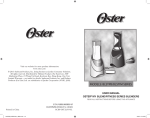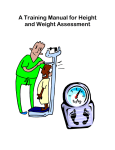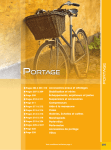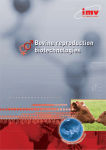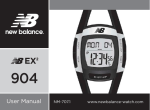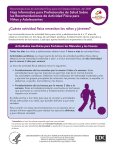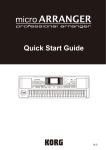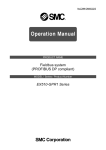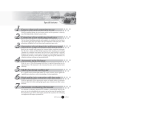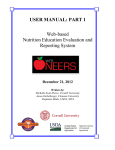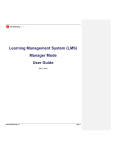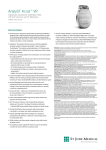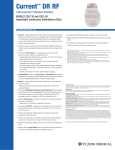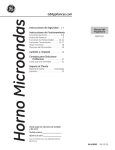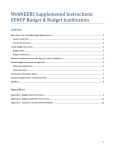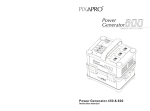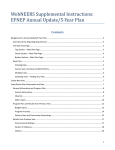Download Katherine Gunter, Ph.D. - Oregon State University Extension Service
Transcript
Author Katherine Gunter, Ph.D. Assistant Professor and Extension Specialist School of Biological and Population Health Sciences Extension Family and Community Health Program Brendan Klein, MPH Extension Family and Community Health Program Revised November 2013 Contents Introduction...........................................................................................................3 Toolkit Inventory.................................................................................................4 Classroom Management....................................................................................5 Using the Toolkit..................................................................................................6 Movement Skills Glossary...............................................................................11 Healthy Living Terminology Glossary........................................................20 Activity Index........................................................................................................22 Additional Activity Resources........................................................................25 2 The Importance of Physical Activity Increasing physical activity and improving nutrition have been identified as two of the greatest challenges currently facing Americans. Regular physical activity in childhood and adolescence has been linked to healthy bones and muscles, improved blood pressure and cholesterol levels, reduced stress and anxiety, and increased self-esteem (1). Data have also shown that active children are far more likely to remain active as adults (5). Toolkit Overview The Balanced Energy-Physical Activity (BEPA) Toolkit integrates physical activity and nutrition concepts through education and activity. Nutrition concepts are linked to physical activity concepts and active games through an approach that explains the concept of balanced energy as a combination of healthful eating and regular, varied physical activity. The BEPA Toolkit provides educators with materials and activity ideas that can be used in and outside of the classroom and before, during, or after school to increase children’s physical activity time at school. BEPA represents an evidence-based, behaviorally focused program that seamlessly integrates the components of energy balance: healthful eating and physical activity. The BEPA Toolkit is… Innovative. Core nutrition messages are integrated with conceptually similar physical activity messages, reinforcing the notion of energy balance through developmentally appropriate experiential learning activities and discussion about relevant key nutrition and physical activity concepts. Versatile. The BEPA Toolkit is for use in before, during, or after school settings; indoors and outdoors. The BEPA Toolkit can be used with any age-appropriate nutrition curriculum to increase and integrate physical activity into existing lesson plans. Practical The BEPA Toolkit provides all the materials necessary to get children active while also reinforcing the importance of healthy eating and active living. The BEPA Toolkit can help schools meet physical education standards requiring 150 minutes of weekly physical activity for elementary age children. The BEPA Toolkit is NOT an “exercise program” designed to build strength, endurance, or physical skills. Although these things may occur as a result of using the kit, the primary goals of the kit are to increase children’s physical activity levels and reinforce the components of energy balance: healthful eating and physical activity. 3 Item Activity Card Packet All 4 Kids CD / DVD Balloons Bean Bags Set of Numbered Cards Dice Foam Basketballs Inflatable Beach Balls Jump Ropes MyPlate Poster Plastic Bin Plastic Buckets Plastic Cones (Blue) Plastic Cones (Orange) Rubber Disks / Poly Spots Scarves # Per Kit 1 1 25 32 1 6 10 20 16 1 1 4 5 5 24 32 4 Classroom Management General Tips Before you begin using the BEPA Toolkit, establish a clear set of rules for each of your classes. These rules should focus on ensuring safety and proper use of the toolkit materials. Work with your class to create a "freeze" word that indicates to students that they should immediately stop what they are doing. This will help to ensure safety and allow you to regain control of the class at any time. Encourage disruptive students to properly engage in the activities by giving them a special role or responsibility. Students who are unengaged may find the activity too easy, too hard, silly or embarrassing. Try to gauge the reason children are unengaged and adjust the activity accordingly. As explained in the BEPA Toolkit Instructions (Page 9), be sure to demonstrate all the movement skills needed for an activity prior to beginning that activity. If children struggle with particular movements or skills, adjust the activity so everyone can fully participate. More classroom management for physical activity information can be found at: http://www.pecentral.org/climate Classroom Arrangement Some classroom arrangements are more conducive to encouraging physical activity than others. Below are four possible classroom layouts to be considered for use with the BEPA Toolkit. Be sure to consult with classroom teachers before making any changes to the classroom layout. Adapted from ABC for Fitness™ Teacher Manual. Copyright 2006 David Katz, Revised September 2008. 5 Using the BEPA Toolkit STEP 1: Select a Nutrition / Physical Activity message combination. If you are pairing the BEPA Toolkit with a nutrition education curriculum, select a Nutrition / Physical Activity message combination that integrates well with the lesson you will be delivering. You can also select an activity using the Activity Index found on Page 22. 6 STEP 2: Use the tabs in the Activity Card packet to find the section coinciding with the message pair you want to use. Select an activity based on the location (indoor/outdoor), age group, and the amount of time available. These details appear in the top-right corner of the activity cards. 7 STEP 3: Review the talking points that appear on the back of each activity card. These will help shape your discussions and aid in integrating nutrition and physical activity concepts within your lesson plan. 8 STEP 4: Review the “Get Ready” section and complete each of the listed steps. Demonstrate* the highlighted movement skills that appear in the activity instructions so all students are ready to move when the activity begins. Provide other movement options if necessary so that all students are able to participate. *See the “Movement Skills Glossary” on Page 11 for help with demonstrating movements for students. **Remember that the goal of the BEPA Toolkit is to increase physical activity, not to teach movement skills. 9 STEP 5: Follow the instruction steps on the activity card. End the activity with a brief discussion about the lesson topic. Use the information provided on the back of the card to guide discussions. 10 Movement Skills Glossary ARM CIRCLES Reach and stretch your arms out wide to your sides in opposite directions. Circle your arms forward, back, or in opposite directions. Arm circles can be small or big, fast or slow, two arms or one arm at a time. CHAIR STANDS Stand in front of a chair with your feet shoulder width apart. Sit back into the chair and quickly stand up. Try to stand up without using your arms to help. CROSS-OVER KICKS Starting position: Stand with your feet about shoulder width apart. Kick your left leg across the front of your right knee; bring it back to starting position. Kick your right leg across the front of your left knee and bring it back to starting position. 11 DRIBBLING THE BALL There are two ways you can dribble a ball. Basketball: Bounce the ball off the ground and back up using your hands. Try to keep the ball under your control for as long as you can. Soccer: Kick the ball softly in front of you as you run. Try to keep the ball close to your feet, rather than kicking it far away. FORWARD KICKS Starting position: Stand with your feet about shoulder width apart. Kick your right leg forward in front of your body and bring it back to starting position. Kick your left leg forward in front of your body and bring it back to starting position. Be careful not to kick other students. GALLOP Starting position: Stand with your feet about shoulder width apart. Extend one leg forward and then bring the other leg behind it. Always lead with the same leg while the other tries to catch up. 12 HOP / JUMP WITH BOTH FEET Starting position: Stand with your feet about shoulder width apart. Bend your legs at the knee and then jump straight up in the air as high as you can. Swing your arms as you jump and reach toward the ceiling to go even higher! HOP / STAND ON ONE FOOT Starting position: Stand with your feet about shoulder width apart. Hop: Swing one leg into the air, bending your knee and raising your arms as you lift yourself off the ground. Land back on the non-swinging leg. Switch sides. Stand: Swing one leg into the air, but don’t jump. Try to keep your balance. Switch legs. IMAGINARY JUMP ROPE Pretend you are jumping rope. Use real jump ropes when space allows. Jump forward, backward, on one foot, two feet. Be creative. 13 JUMPING JACKS Put your hands up in the air above your head, palms facing inward and spread your legs out. Quickly bring your arms to your sides and your feet together. Repeat. KNEE RAISES Stand straight up and slowly bring one knee up towards your chest while keeping your upper body stable, then slowly bring the leg down. Repeat with the other leg. LUNGE / FORWARD LUNGE Place your hands on your hips. Standing with your feet together, step your right leg forward and bend your left knee down toward the ground. Make sure your right knee does not go past your right foot. Your left knee should be pointing down and your right knee should be pointing forward. Push up off your right foot and return to you starting position. Repeat with your left leg. 14 MARCH WITH HIGH KNEES March forward or in place. As you bring each knee up bring it as high toward the ceiling as possible. OVERHEAD REACHES Put your arms above your head, now pretend like you are climbing a rope, so as the right arm comes down your left arm reaches up higher and vice versa. PUSH UPS Starting position: Place your hands on the floor about shoulder width apart in a comfortable position. Extend your legs behind you and rise up onto your toes. Keep your body straight (no sagging hips or bottoms in the air) with your head up. You will be holding your body up on four points (toes and hands) in a straight line. If you can, bend your elbows and lower your whole body toward the floor and then push back up to the starting position. You can also try it on your knees. Another option is to just try holding yourself in the starting (up) position. 15 SHOULDER BLADE SQUEEZES Stand or sit with your back straight. Slowly squeeze your shoulder blades together by moving your shoulders backward. Imagine your shoulder blades touching. Hold for a few seconds, relax and repeat. SHUFFLE / SIDEWAYS SLIDE Starting position: Stand with your feet about shoulder width apart (a). Keep one foot planted in place and step out to the side with the other leg so you are standing in a straddle position (b). a b c Slide your planted leg over so that you are standing in the starting position. Repeat to the other side (c). SIDE-TO-SIDE JUMPS Starting position: Stand with your feet about shoulder width apart. Extend your right leg to the side and jump to the right. Bring your left leg along as your right foot makes contact with the ground. Repeat with your other leg. 16 SIT UPS Lie on the ground on your back and bend your knees so your knees point up toward the ceiling. Without moving your legs or pulling on your head/neck, bring your chest up toward your knees. Slide your hands along the floor toward your feet. Slowly lower your back down to the ground and repeat. SKIPPING Starting position: Stand with your feet about shoulder width apart. Lift your right knee straight up toward your chest. At the same time, jump into the air using your left leg. Once you have landed, switch legs and repeat. SQUATS / DEEP SQUATS Starting position: Stand with your feet about shoulder width apart. Bend your knees and lower your body so your moves bottom down and backward; pretend like you are going to sit back in a chair. Try to keep your weight more on your heels than on your toes. When you have lowered to about the height of a chair, pause and then use your leg muscles to stand back up. 17 STAR JUMPS a b Start in a tucked or squat position (a). Then, jump up and explode into the air. Spread your arms and legs out to make a “star” as you jump (b). TOE RAISES Starting position: Stand with your feet about shoulder width apart. While keeping your toes on the ground, raise the heels of both your feet into the air. Hold your heels up for a few moments before lowering them back to the ground. Repeat. Be careful to keep your balance! WALKING HEEL-TO-TOE Walk in a straight line so that the heel of your front foot is always placed directly in front of the toes of your back foot. Look up so you don’t walk into a classmate, a wall or a desk! 18 ZIG-ZAG WALK Walk forward in a straight line, but when you step with your right leg cross it in front of left leg and when you step with your left leg cross it in front of your right. You could also do this travelling in a sideways direction. When you move sideways this is called a grapevine 19 Healthy Living Terminology Glossary Aerobic Physical Activity: Promotes cardiovascular (heart) health. It is important to spend at least 60 minutes a day doing moderate to vigorous physical activity. This may include activities such as running, jogging, walking, swimming, and dancing. Balance: The body’s ability to maintain stability while stationary or moving. Balance Activities: Activities that help build coordination and lower the risk of falls, especially as we get older. Balance exercises are not hard and can be a great activity for children, parents, and grandparents to do together! Practicing balance (e.g. standing on one leg, walking heel-totoes) enables you to be able to do all activities more effectively and with greater stability. “Benefit Dense” Activity: Activity that includes many different fitness components and benefits such as strengthening, cardiovascular, balance, flexibility, and coordination. Examples of benefit dense activities include ice-skating, gymnastics, and rock climbing. Bone Building (Strengthening) Activities: Weight bearing activities such as jumping, soccer, dance, gymnastics, and running games (with lots of direction changes and stops/go's such as tag) are great for bone building. It’s important to include some activities that are good for bone such as jumping and muscle strengthening exercises. Cardiovascular Fitness: A health-related component of physical fitness describing the ability of the circulatory and respiratory systems to supply oxygen during sustained physical activity. Coordination: Coordination in fitness refers to the ability, especially of several muscles or muscle groups, to smoothly execute complicated movements. Empty Calories: Calories from solid fats and/or added sugars that provide no nutritional benefit. Energy Balance: The balance of calories consumed from foods and beverages (Energy In) with calories burned from physical activity (like walking, climbing stairs, playing sports or playing at recess, getting dressed, eating, cleaning your room, reading, or sleeping (Energy Out). Flexibility: The range of motion at a joint. Flexibility exercises are important because they improve the ability of a joint to move through its entire range of motion and help protect muscles. Flexibility Activities: These activities may help to reduce the risk of injury when doing other activities. Flexibility exercises (e.g. stretching) keep your muscles healthy and limber and allow muscles to move through an entire range of motion. Healthy Food: Foods from plants or animal products that provide essential nutrients and energy for growth, health and life. Particularly vegetables, fruit, lean protein, whole grains, and fat free dairy items. 20 Moderation: Not doing something excessively. Avoiding extremes. Moderate Intensity Physical Activity: Any activity done at 3 to 5.9 times the intensity of rest. Typically, you can talk during these activities but cannot sing. Moderate intensity physical activity can be very different for every individual. Muscle Strengthening Activities: Activities that increase skeletal muscle strength, power, endurance, and mass. Children and adolescents should include muscle-strengthening activities at least 3 days a week. Muscle strengthening activities include: playing games such as tug-of-war, push-ups, sit-ups and climbing. My Plate Food Groups: Vegetables, Fruits, Grains, Protein and Dairy. Physical Activity: Any bodily movement produced by the skeletal muscles that uses energy. Physical Activity Benefits: Benefits of physical activity include: physical benefits such as reduced risk for disease, weight management and increased energy, emotional/mental benefits such as improving your mood, and social benefits because physical activity is fun and a great way to make new friends. ‘Personal’ Space: When each child is standing, they should have enough room so that when they spread out their arms they are not touching other individuals. Pulse: The rhythmical throbbing of arteries produced by the regular contractions of the heart. Your pulse can be found by placing the pointer and middle fingers of the right hand on the left wrist, in line with the left thumb, just below where the wrist bends. By counting your pulse you can determine the heart rate response during a light, moderate, and vigorous activity. Sedentary activities: Sedentary activities include: sitting in front of the computer, watching TV, and playing video games. Two or more hours of inactivity are discouraged for children, especially during daytime hours. Strength: The ability of a muscle, or group of muscles, to exert force. Tandem Walk: A balance exercise in which the toes of the back of the foot touch the heel of the front of the foot at each step. Unhealthy Food: Foods high in solid fats, added sugars, and salt. These are foods that should be avoided or eaten on very rare occasions. Vigorous Intensity Physical Activity: Any physical activity done at 6 or more times the intensity of rest (on an absolute scale). These activities may include walking up hills and running games. If you are doing a vigorous activity you can only say a few words without stopping to catch your breath. It is recommended children and adolescents participate in vigorous activity at least 3 days per week. Vigorous intensity physical activity can be very different for every individual. 21 Activity Index All the activities included in the BEPA Toolkit are listed below. Activities requiring larger activity space, as well as those activities that involve relevant topics (MyPlate, Breakfast, Dance Activities) are indicated. MyPlate/ Food Groups Breakfast Dance/Song Activities Balancing Calories Hop Around My Plate Toss Across OUTDOOR Moving Questions Dicey Moves Speed Scarves Line Up for Balance OUTDOOR Bean Bag Balance Enjoy your food, but eat less A Healthy Week Food Group Fitness Bean Bag Football OUTDOOR I'm a Food, You're a Food We Like to Move It Bucket Ball OUTDOOR Avoid oversized portions Amoeba Racing OUTDOOR Blog Tag OUTDOOR Take a Break I Like to Move Dance Ball Roll Up Bung-A-Low Ready Go Foods to increase Food Group Ball Pass Color My Plate Food Group Fun Activity Stations 22 Find the Veggie Fruit and Veggie Fun OUTDOOR Muscle Tag OUTDOOR Four Corners OUTDOOR OUTDOOR OUTDOOR Treasure Rescue OUTDOOR Partner Tag OUTDOOR Make half your plate vegetables & Fruit Overhead Relay Fruit and Veggie Volleyball Fruit Salad INDOOR/OUTDOOR INDOOR/OUTDOOR Fruit and Veggie Zigzag Color My Plate Tag Make at least half your grains whole grains Race Against Time Cross the River OUTDOOR Dancing Body Parts Moving Corners Switch to fat free or low fat milk Food Group Race Buy a Vowel Calcium Ball OUTDOOR Go Bananas Bone Up at Breakfast The Breakfast Song Foods to reduce Couch Potato Empty Calories OUTDOOR Copy Cat Tails OUTDOOR Snowball Fun OUTDOOR Over, Under, Around and Through INDOOR/OUTDOOR Choose food with low sodium Stop and Scribble 23 Healthy Says Always on the Move Have a Ball What's My Activity Moovin' & Groovin' Human, Banana, Soda Pop True or False Activate the Alphabet Animal Acts World's Strongest Students Tightrope OUTDOOR Drink water instead of sugary drinks 24 Additional Activity Resources Some activities require the instructor to come up with examples or a set of questions about the lesson. Resources for those activities can be found below. Balancing Calories – Moving Questions: Sample Questions about Balancing Calories Q: What does it mean to balance your calories? A: Caloric balance is when the calories you eat / drink are balanced by the calories used (in normal body functions, daily activities, and exercise). It is important to balance your calories in order to remain, healthy and fit. Q: Should all people of the same age, size, and gender consume the same amount of calories? A: No. Generally, active people should eat more than less active individuals. Even if two people have the same appearance, the more active person will need more nutritious foods and calories to fuel those activities. Q: How do I balance my calories? A: In order to balance your calories it is important to choose and consume healthy foods and beverages and to be physically active. This will help you to live a healthy lifestyle. Q: What happens when you do not balance your calories? A: When your calories are out of balance you may gain or lose weight. Having unbalanced calories may also lead to some health problems. Q: What are some ways that your calories could become unbalanced and your weight could increase or decrease? Is one better than the other? A: Increasing / decreasing physical activity OR increasing / decreasing caloric intake. Either gaining or losing too much weight can be unhealthy. It is important to balance your calories in order to remain healthy and grow up big and strong. Make Half your Grains Whole Grains – Four Corners / Race Against Time: Sample Questions about Whole Grains and Muscle Strength Q: How much of the grains you eat should be whole grains? A: At least 50%, but the more the better! Q: Why is it important to eat whole grains? A: Eating whole grains provide many health benefits. Whole grains provide more nutrients and are better for our bodies than refined grains. Q: How do you know if a food is made from whole grains? A: Look on boxes and labels of foods like cereals, breads, crackers, rice, and pasta. Choose foods that say they are made from 100% Whole Grains. Q: Why is it important to participate in muscle strengthening activities? A: Our muscles are an important part of our bodies that we use to do all of our movements. 25 Q: How often should you participate in muscle strengthening activities? A: At least 3 days each week. Q: What are some examples of muscle strengthening activities? A: Sit-ups, Push-ups, Climbing, Gardening. Also balance and flexibility activities such as standing on one foot and stretching. Switch to Fat Free or Low Fat Milk – Buy a Vowel: Examples of Healthy Dairy Foods/Drinks and Other Calcium Rich Foods Dairy: Fat free or low fat milk, yogurt, frozen yogurt, cheese, pudding Calcium Rich: Soymilk, dark leafy greens (spinach, etc.), orange juice, soybeans Choose Food with Low Sodium – Stop and Scribble: Examples of the Different Types of Physical Activity Benefits Physical: stronger bones, stronger muscles, stronger heart, feeling strong and healthy! Mental / Emotional: reduced stress and anxiety, increased confidence, feel happier! Social: Physical activity is a great way to meet friends and have fun! Drink Water Instead of Sugary Drinks – True or False: Sample True/False Questions about Sugary Drinks and Sedentary Activities Q: It is not important to drink water every day. A: False. Your body needs water every day to remain healthy. Q: Fruit juice is healthy, so you can drink as much of it as you want. A: False. 100% fruit juice is good for you, but it also has a lot of sugar, so you should drink it in moderation. Q: If there are soda machines in school that means it is okay to drink soda at lunch. A. False. Soda has a lot of sugar and empty calories with no nutritious value. If possible you should not drink any soda or drink it very rarely. Q: Sedentary activities are when you are inactive and not moving around. A: True. Watching TV, playing video games, and spending time on the computer are all examples of sedentary activities. Q: It is okay for you to be sedentary / inactive for several hours each day as long as you exercise for a little while. A: False. Children should avoid being inactive for more than two hours at a time to remain healthy. Q: Sleep is a sedentary activity. A: False. Although you are not active while you are sleeping, it is not considered a sedentary activity. Getting enough sleep is important in order to remain healthy and grow into a strong adult. 26 References and Resources 1. Centers for Disease Control. (2012, June 7). Adolescent and school health: Physical activity facts. Retrieved from http://www.cdc.gov/healthyyouth/physicalactivity/facts.htm 2. Centers for Disease Control. (2011, February 16). Physical activity and health: The benefits of physical activity. Retrieved from http://www.cdc.gov/physicalactivity/everyone/health/index.html 3. Dietary Guidelines Advisory Committee. (2010). Report of the Dietary Guidelines Advisory Committee on the Dietary Guidelines for Americans, 2010, to the Secretary of Agriculture and the Secretary of Health and Human Services. Washington, DC: USDA, ERS. 4. National Association for Sport and Physical Education. (2012). Physical activity for children: A statement of guidelines for children ages 5-12. Retrieved from http://www.aahperd.org/naspe/standards/nationalGuidelines/PA-Children-5-12.cfm 5. President's Council on Fitness, Sports & Nutrition. (2012). PCFSN research digests: Health benefits of physical activity during childhood & adolescence. Retrieved from http://www.fitness.gov/childhood.htm 27 Funded by USDA NIFA, Grant Number 2011-68001-30020. © 2013 Oregon State University. Extension Family and Community Health Program. Contributing authors Gunter, K.B., Klein, B.D. All rights reserved. 28




























